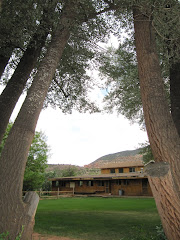Spark in the Dark- -Wintogreens, How does that work?
 Filed Under :
Activities
by Navajo Trails Summer Camp
Filed Under :
Activities
by Navajo Trails Summer Camp Saturday, July 3, 2010
Saturday, July 3, 2010This effect is called triboluminescence, which is similar to the electrical charge build-up that produces lightning, only much less grand. Triboluminescence is the emission of light resulting from something being smashed or torn. When you rip a piece of tape off the roll, it will produce a slight glow for the same reason.
Triboluminescence occurs when molecules, in this case crystalline sugars, are crushed, forcing someelectrons out of their atomic fields. These free electrons bump into nitrogen molecules in the air. When they collide, the electrons impart energy to the nitrogen molecules, causing them to vibrate. In this excited state, and in order to get rid of the excess energy, these nitrogen molecules emit light -- mostly ultraviolet (nonvisible) light, but they do emit a small amount of visible light as well. This is why all hard, sugary candies will produce a faint glow when cracked.
But when you bite into a Wint-O-Green Life Saver, a much greater amount of visible light can be seen.
This brighter light is produced by the wintergreen flavoring. Methyl salicylate, or oil of wintergreen, isfluorescent, meaning it absorbs light of a shorter wavelength and then emits it as light of a longer wavelength. Ultraviolet light has a shorter wavelength than visible light. So when a Wint-O-Green Life Saver is crushed between your teeth, the methyl salicylate molecules absorb the ultraviolet, shorter wavelength light produced by the excited nitrogen, and re-emit it as light of the visible spectrum, specifically as blue light -- thus the blue sparks that jump out of your mouth when you crunch on a Wint-O-Green Life Saver.











No comments:
Post a Comment